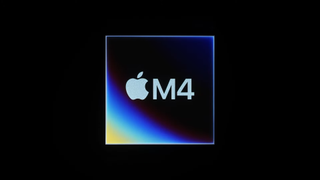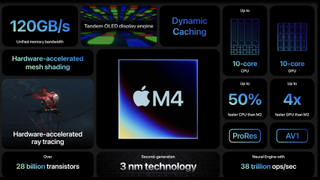Apple M4 Specs, benchmarks, release date, and pricing
Apple’s next-generation M4 processor family should debut in late 2024

Apple has announced its new M4, the latest in the line of high-end Apple Silicon chips. Surprisingly, the new chip didn’t debut in a Mac but instead in the company’s new 11- and 13-inch iPad Pros. The company explained that the existing M3 couldn’t handle the technological advances incorporated into the new iPad Pros, and only the M4 would suffice. So, what exactly does the M4 bring to the table?
The M4 is built using a second-generation 3-nanometer process node (TSMC N3E), which is a refinement of the node used for the M3 (N3B). It is the successor to the M3 family, which first debuted in October 2023 in the M3, M3 Pro, and M3 Max.
Apple M4 At a Glance (iPad Pro configuration)
- CPU with up to 4 performance cores, 6 efficiency cores, 28 billion transistors
- 10-core GPU
- 16-core Neural Engine (38 TOPS)
- Second-generation 3-nanometer process node (TSMC N3E)
- Launches mid-May 2024
- Up to 16GB of unified memory
- 120 GB/s unified memory bandwidth
Apple M4 Benchmarks, Specifications and Features
The M4 is the first of Apple's fourth-generation “M Series” processors. We don’t currently have official clock speeds or actual performance numbers for the M4, but we have seen early benchmarks posted to public databases that imply the chip is the fastest in the world in single-core performance. Tom's Hardware can’t validate those results, however.
Instead, Apple has provided only vague comparisons to previous-generation processors. For example, Apple says that the M4, as used in the iPad Pro, is up to 1.5x more powerful than the M2 used in the previous generation model. However, we can’t really compare these numbers to the versions of the M4 that will appear in future MacBook Air or iMac models, as those devices are less thermally constrained. In addition, it’s claimed that the M4 can deliver the same performance as the M2 while using only half the amount of power. Compared to the M2, M4 is also said to improve thermal performance by up to 20 percent.
The 10-core GPU in the M4 brings support for Dynamic Caching and hardware-accelerated ray tracing. These features were first introduced in previous Apple Silicon chips like the A17 Pro and the M3. Apple claims that rendering performance in Octane is up to four times faster compared to M2. Apple also makes the spurious claim that the M4 can deliver the same performance as an Asus Zenbook 14 OLED (UX3405MA) with Core Ultra 7 155H and 32GB of RAM while using just a quarter of the power.
Artificial Intelligence (AI) is expected to sit front and center during Apple’s WWDC 2024 keynote in June. The next versions of iOS, iPadOS and macOS are expected to greatly leverage AI for background work and user-facing features. As a result, Apple continues its year-over-year improvements in Neural Processing Unit (NPU) performance with the M4. The 16-core neural engine in the M3 is capable of 38 trillion operations per second (TOPS). For reference, Qualcomm claims that the NPU in the competing Snapdragon X Elite is capable of up to 45 TOPS.
Another important puzzle piece in the M4 is its Media Engine, which supports all of today’s popular video codes including H.264, HEVC and Apple’s own ProRes. In addition, the M4 enabled the iPad Pro family to support hardware acceleration for AV1 for the first time.
Stay On the Cutting Edge: Get the Tom's Hardware Newsletter
Get Tom's Hardware's best news and in-depth reviews, straight to your inbox.
Apple M4 Chip Positioning
According to Bloomberg’s Mark Gurman, the first three M4 variants are codenamed Donan (entry-level), Brava (high-performance), and Hidra (flagship performance), which should correspond with M4, M4 Pro/Max, and M4 Ultra, respectively. We’ve already seen the M4 in the latest iPad Pro, but the chip (in various bins) will likely end up in MacBook Air, entry-level MacBook Pro, iMac, and Mac mini systems. The eventual M4 Pro should find its way into MacBook Pro and Mac Mini systems. M4 Max will be the domain of MacBook Pro and Mac Studio, while M4 Ultra will find a home in Mac Studio and Mac Pro systems. It should be noted that Apple has yet to release Mac Studio or Mac Pro systems with M3 Ultra.
| Header Cell - Column 0 | M1 | M1 Pro | M1 Max | M1 Ultra | M2 | M2 Pro | M2 Max | M2 Ultra | M3 | M3 Pro | M3 Max | M4 (iPad Pro) |
|---|---|---|---|---|---|---|---|---|---|---|---|---|
| CPU Cores | 8 | 8 or 10 | 10 | 20 | 8 | 10 or 12 | 12 | 24 | 8 | 11 or 12 | 14 or 16 | 9 or 10 |
| GPU Cores | 7 or 8 | 14 or 16 | 24 or 32 | 48 or 64 | 8 or 10 | 14 or 16 | 30 or 38 | 60 or 76 | 8 or 10 | 14 or 18 | 14 or 18 | 10 |
| Neural Engine | 16 cores, 11 TOPS | 16 cores, 11 TOPS | 16 cores, 11 TOPS | 32 cores, 22 TOPS | 16 cores, 15.8 TOPS | 16 cores, 15.8 TOPS | 16 cores, 15.8 TOPS | 32 cores, 31.6 TOPS | 16 cores, 18 TOPS | 16 cores, 18 TOPS | 16 cores, 18 TOPS | 16 cores, 38 TOPS |
| Maximum Unified Memory | 16GB | 32GB | 64GB | 128GB | 24GB | 32GB | 96GB | 192GB | 24GB | 36GB | 128GB | 16GB |
| Memory Bandwidth | 68.25 GB/s | 200 GB/s | 400 GB/s | 800 GB/s | 100GB/s | 200 GB/s | 400 GB/s | 800 GB/s | 100 GB/s | 150 GB/s | 300 GB/s or 400 GB/s | 120 GB/s |
| Transistors | 16 billion | 33.7 billion | 57 billion | 114 billion | 20 billion | 40 billion | 67 billion | 134 billion | 25 billion | 37 billion | 92 billion | 28 billion |
Chip Configurations and AI
As is the case with the M3 family, there will likely be binned versions of each chip, with multiple CPU and GPU core configurations available paired with varying amounts of RAM. For instance, the M3 Pro offers 11-core CPU/14-core GPU and 12-core CPU/18-core GPU configurations. Likewise, the M3 Max is available in 14-core CPU/30-core GPU and 16-core CPU/40-core GPU configurations. Expect similar binning options for the M4, which uses a second-generation 3nm process node.
Right now, we only know of two configurations for the M4-series processor (iPad Pro). 256GB and 512GB versions of the iPad Pro feature a 9-core CPU (3 performance cores, 6 efficiency cores) paired with 8GB of unified memory. The second configuration – found in 1TB and 2TB SKUs – features a 10-core CPU (4 performance cores, 6 efficiency cores) coupled with 16GB of unified memory. Both M4 chips feature 28 billion transistors, 10 GPU cores, a 16-core neural engine, and 120 GB/s memory bandwidth.
Apple's MacBook Pros currently offer top-range M3 Max configurations with up to 128GB of unified memory. Apple Silicion desktop Macs have yet to transition to the M3 family, so M2 Ultra configurations are currently limited to a maximum of 192GB of unified memory. Gurman suggests that the limit for desktop Macs (Mac Studio and Mac Pro) could expand greatly to 512GB with the M4 line. That figure still pales compared to previous-generation Intel-based Mac Pros, which could accommodate up to 1.5TB of memory.
The M3 features a 16-core Neural engine capable of 18 TOPS. The M4 more than doubles that to 38 TOPS. Apple is said to make AI operations a big focus of its next-generation operating systems, which are due to launch for consumers in Fall 2024. Most of these AI operations will be run on-device rather than in the cloud, which is in keeping with Apple's privacy-focused mantra.
Apple M4 Release Dates and Pricing
Release Dates
Based on what we know at this point, this is the firing order for all the upcoming iPad Pros and Macs destined to receive a variant of the M4 processor:
| Mac Model | Expected M4 Series Chips | Expected Launch Date |
|---|---|---|
| 11- and 13-inch iPad Pro | M4 | Mid-May 2024 |
| 14-inch MacBook Pro (Base) | M4 | Late 2024 |
| 24-inch iMac | M4 | Late 2024 |
| 14-inch and 16-inch MacBook Pro | M4 Pro, M4 Max | Late 2024, Early 2025 |
| Mac Mini | M4, M4 Pro | Late 2024, Early 2025 |
| 13- and 15-inch MacBook Air | M4 | Spring 2025 |
| Mac Studio | M4 Max, M4 Ultra | Spring 2025 |
| Mac Pro | M4 Ultra | Late 2025 |
Apple M4 Pricing
At this time, the only available Apple product with an M4 processor onboard is the 2024 iPad Pro family. The iPad Pro is available in two screen sizes: 11-inches and 13-inches. While both feature Apple’s new 120Hz Ultra Retina XDR Display with “Tandem OLED” technology, the former has a resolution of 2420 x 1668, while the latter comes in at 2752 x 2064.
Both models are available in 256GB, 512GB, 1TB, and 16TB storage configurations, starting at $999 for the 11-inch model and $1,299 for the larger 13-inch tablet.
| Header Cell - Column 0 | 256GB | 512GB | 1TB | 2TB | Cellular | Nano-Texture Display |
|---|---|---|---|---|---|---|
| iPad Pro (11-inch) | $999 | $1,199 | $1,599 | $1,999 | +$200 | +$100 |
| iPad Pro (13-inch) | $1,299 | $1,499 | $1,899 | $2,299 | +$200 | +$100 |
MORE: Qualcomm Snapdragon X Elite and X Plus All We Know
MORE: Zen 4 Ryzen 7000 All We Know
MORE: Raptor Lake All We Know
Brandon Hill is a senior editor at Tom's Hardware. He has written about PC and Mac tech since the late 1990s with bylines at AnandTech, DailyTech, and Hot Hardware. When he is not consuming copious amounts of tech news, he can be found enjoying the NC mountains or the beach with his wife and two sons.
-
cknobman More power that 99% of users out there didnt need.Reply
Why?
Cause more better and suckers will spend mo money on it!!!! -
CarlosO I would rather see longer battery life on iphone, so it would last longer than until the end of the day...the same for Apple watch...anything with Apple silicone except ipad and Macbook is actually draining the battery big time...Reply -
Notton Out of all the reviews I have seen, the only person who looks to benefit from an M4 ipad is someone like Dave2D.Reply
So, big youtube channel, editing on the fly....
So, like 20,000/8,100,000,000 people in the world would see a tangible benefit to using M4 ipad. And that's being generous.

